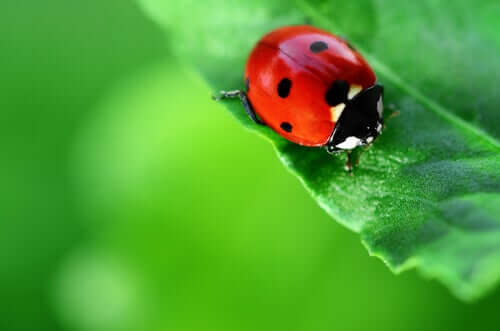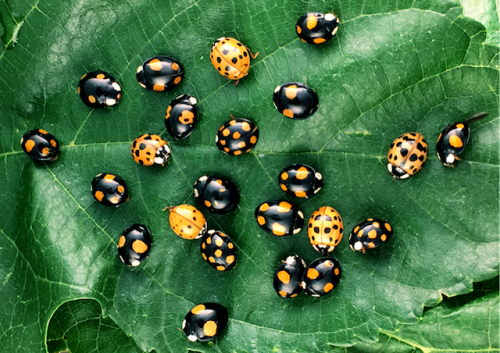Ladybird Beetle - Characteristics and Behavior

Isn’t it true that, when we think of a ladybird beetle, we envision an insect with a blackhead and a red back with its characteristic black spots? They’re definitely one of the most colorful bugs, although there are many more varieties with other colors and shapes. Farmers adore them. Why? Continue reading to find out.
Features
The ladybug is a coleopterous insect. That is, it’s actually a beetle that’s closely related to other bugs such as weevils, stag beetles, and even fireflies.
As we said above, everyone thinks that ladybirds are round, red insects with black spots. However, we also mentioned that there are many varieties of ladybugs out there: orange, yellow and they have diverse patterns of dots. The dots are usually black.
The bright colors of this family of beetles are mainly for warning potential predators about their venom selves or to indicate they’re not tasty. Actually, ladybird beetles have hardly any predators at all. But there are some larger birds and insects that prey on them. For instance, a swallow will eat them. But they rarely do because these bugs taste really bad.
Ladybugs are invertebrate insects. What this means is they lack bones and are about 1/4 – 1/2 inch in size. They’re diurnal animals, which means they must take advantage of the daylight to carry on. They hide during the night and during the winter months, they enter a state that’s similar to the hibernation of other species. They come out again in the spring.
Habitat of a ladybird beetle
Ladybugs live in every corner of the planet, mainly in the countryside. They’re easy to spot because they seldom hide. In fact, they often climb to the top of a plant and hang out on their leaves.
The only thing a ladybird beetle cares about when it comes to selecting a plant is whether it has aphids or not. This is because they feed on them. If there are aphids on a plant, these critters will either be on it or near it.
You can see ladybugs in all sorts of places but particularly in those where they can catch some food — fields, gardens, and parks. They’re attracted to brightly colored walls and thus by green areas. They’ll migrate to any place where they can find tasty critters.
Ladybird beetle – behavior
These friendly beetles are independent animals. That is to say, they’re solitary creatures that spend their day alone, searching for food.

In terms of reproduction, a single ladybird beetle can release up to 400 eggs into each pouch, and the eggs usually hatch into larvae between March and April. It’s common for them to stay on the leaves of plants that have aphids, as larvae begin to feed before they become adults. A ladybird’s entire cycle lasts about two months, and when winter arrives they’ll repeat the process of hibernation.
Ladybirds are highly independent, but they gather in large groups when it comes to hibernating. Thus, several of them gather to spend the winter together and protect themselves from the cold. Also, because they’re all together when they wake up in early spring, it’s easier for them to mate right then and subsequently reproduce.
Their longevity depends on their subfamily. One can say that they live for about a year on average, although some of them can live up to three years. This is quite an achievement if you take into account they’re very small bugs.
Why do farmers love the ladybird beetle?

Because ladybird beetles feed on aphids and not on plants, one can say they’re a “natural” pesticide. In fact, they can deplete harmful aphid populations so gardeners don’t have to use toxic chemicals.
Also, ladybugs are used in some places to control aphid and mite pests. Some say that a single ladybird can eat up to 1000 bugs over the course of a summer, so they’re very valuable as biological control. You can just release some ladybugs in those crops that are heavily affected by aphids and let them eat.
Ladybird beetles are important for ecological balance. For instance, there’s no need to spray crops with toxic chemicals if they can keep aphids at bay. The aphids aren’t necessarily harmful to humans, mainly to other insects and to the birds that eat them. Thus, ladybugs help keep food chains safe.
Finally, ladybugs are symbols of good luck in some countries. They’re one of the most visible and appreciated insects. Most likely because ladybird beetles are friendly insects that help so much with the ecological balance of our countryside.
All cited sources were thoroughly reviewed by our team to ensure their quality, reliability, currency, and validity. The bibliography of this article was considered reliable and of academic or scientific accuracy.
- Obrycki, J. J., & Kring, T. J. (1998). Predaceous Coccinellidae in biological control. Annual review of entomology, 43(1), 295-321.
- Obrycki, J. J., Harwood, J. D., Kring, T. J., & O’Neil, R. J. (2009). Aphidophagy by Coccinellidae: application of biological control in agroecosystems. Biological control, 51(2), 244-254.
- Roy, H., & Migeon, A. (2010). Ladybeetles (Coccinellidae). Chapter 8.4. BioRisk, 4, 293-313.
- Biranvand, A., Jafari, R., & Khormizi, M. Z. (2014). Diversity and distribution of Coccinellidae (Coleoptera) in Lorestan province, Iran. Biodiversity Journal, 5(1), 3-8.
- Lami, F., Masetti, A., Neri, U., Lener, M., Staiano, G., Arpaia, S., & Burgio, G. (2016). Diversity of Coccinellidae in ecological compensation areas of Italy and overlap with maize pollen shedding period. Bulletin of Insectology, 69(1), 49-57.
This text is provided for informational purposes only and does not replace consultation with a professional. If in doubt, consult your specialist.